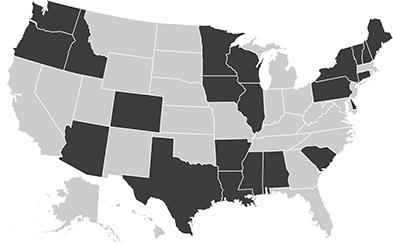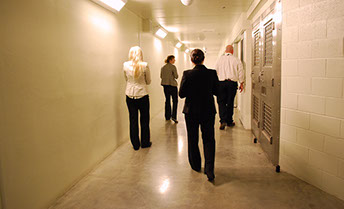Programmatic Accommodations for Inmates with Disabilities Under the Americans with Disabilities Act
Making Hard Time Harder
Amplifying Voices of Inmates with Disabilities Prison Project
by Rachael Seevers | June 22, 2016
The disproportionate incarceration of people with disabilities in the United States is a serious and growing problem. As the prison population ages, more inmates are reporting physical disabilities.1 The U.S. has also seen a rise in the number of people with mental illness and developmental and cognitive disabilities in prison.2 National surveys now indicate that as many as 31 percent of inmates in state prisons report having at least one disability.3
While prison is hard for everyone, incarceration is even more challenging for inmates with disabilities. Research shows that inmates with disabilities are sentenced to an average of fifteen more months in prison as compared to other inmates with similar criminal convictions.4 The time they serve is also harder, with more sanctions imposed and less access to positive programming than other inmates.5 Prisoners with disabilities are also four times more likely to report recent psychological distress as compared to inmates without disabilities.6 In a system intended to control and sanction behavior believed to violate the many regulations that govern prison life, inmates with disabilities who need accommodations are often overlooked, ignored, or even punished.
Very few outsiders are allowed into the prisons, and the public rarely gets to witness the conditions in which many inmates are confined. In recent years, protection and advocacy agencies (P&As), organizations granted with special federal authority to enter facilities that serve people with disabilities, have been going behind prison walls to identify issues facing inmates with disabilities.
P&As have received reports of inmates forced to drag themselves across their cell or sleep on the floor because their cane or walker was removed. Inmates with cognitive disorders, intellectual disabilities, or mental illness have sought assistance because they are unable to complete the programming required to move out of restrictive housing, forcing them to remain in segregation for years, if not decades.7 These same inmates may be punished for failing to follow the written rules of the prison, rules they either cannot read or cannot understand due to a disability, resulting in sanctions, loss of good time, or even additional criminal charges. Inmates in need of therapeutic diets or those who require assistance in activities of daily living often find themselves caught in an endless cycle of institutional grievances and appeals as they seek approval for accommodations in correctional policy and practice.

In recognition of the growing population of inmates with disabilities, in 2012 Disability Rights Washington, the P&A for Washington State, began focusing more attention on the state’s prisons, investigating the conditions of these correctional settings and working on creative solutions to some of the most serious problems faced by inmates with mental illness, brain injuries, and physical and intellectual disabilities. In early 2014, with increased funding through a private grant, Disability Rights Washington created Amplifying Voices of Inmates with Disabilities (AVID), a project with the sole purpose of protecting and advancing the rights of inmates with disabilities and assisting those who are reentering society.8 In September 2014, AVID brought together staff from the P&As in New York, South Carolina, Arizona, Colorado, Louisiana, and Texas, as well as from the National Disability Rights Network, to strategize about ways to increase national attention on the issues faced by inmates with disabilities.
This report, which has grown out of that collaborative national effort, aims to highlight the difficulties that inmates with disabilities face as they seek to access programs and services in state prison systems.9 P&As from across the country provided examples of either past or ongoing advocacy to enforce the protections of the Americans with Disabilities Act (ADA) on behalf of inmates with disabilities. By no means exhaustive, this report provides an overview of the protections afforded to inmates with disabilities under the ADA as well as examples in which P&As have advocated effectively on behalf of inmates with disabilities.10 This advocacy is multi-modal, ranging from routine monitoring, to informal and individual advocacy, to systemic litigation.
A prison sentence shouldn't be harder, it shouldn't be longer, and conditions of confinement shouldn't be harsher simply because of a disability.
This report begins with a brief overview of the P&A system, describes the different types of advocacy P&As use, and outlines the ADA’s application to prisons. Next, this report details the work P&As across the country have done to advance inmates’ rights under the ADA, focusing on three main areas of prison life: (1) hygiene, health, and safety, (2) accommodations in communication, and (3) access to programming and services. A review of this work reveals that while the ADA has been in place for more than 25 years, much remains to be done to bring programs and buildings in the nation’s prisons into compliance with the requirements of the ADA. This report concludes with a series of recommendations for future action. Highlights from those recommendations include:
- Increased federal funding to the P&A network for corrections-based monitoring and advocacy;
- Creation of independent corrections ombuds offices at the state level in order to address inmate concerns before they rise to the level of litigation;
- Systemic accessibility reviews by state departments of corrections to identify both physical and programmatic barriers for inmates with disabilities;
- Increased training for prison ADA coordinators and collaboration between these staff members and the local P&As to address inmate concerns. More recommendations
Ultimately, this report is intended to spur interest and action within the P&A network and other prison advocacy groups and increase focus on what has become a crisis within the nation’s prison system.
Download .docxDownload PDF
The Voices
Brenda Charity
"My name is Brenda Charity. I came here in March of 2015, and we're at Denver Women's Correctional Facility. I've always been told by my doctors outside that if I try and use the elliptical, do light weights-- that helps my circulation and my heart. So, I was on the elliptical and doing five-pound weights, trying to lift to strengthen myself, and my accommodations were taken away because of that... Each time I would send in something to ADA, medical would send it, 'well, we saw her exercise. That's why we took it. If she can exercise, she doesn't need it.' Well, that's not true." | Full transcript
Tyrone Gathings
"My name is Tyrone Gathings. I have a vision disability. I was diagnosed with retinitis pigmentosa, RP. I was diagnosed with this back in 1979... Right now, they got me going to Walla Walla Community College, and I really haven't accomplished anything. I would've liked to extend my education. Like I said, I require visual aids in order to keep up with the rest of the class. I haven't been afforded any of that. Sometimes you're just put off in the corner to sit to the side, and it's kind of frustrating after a while. The way it is now, I'm just basically going back out there with no skills." | Full transcript
Overview of the Protection & Advocacy System
The P&A system was created in the 1970s after a series of news reports exposed the horrific institutional conditions in which people with developmental disabilities were housed.11 This news coverage prompted federal legislation to create a national network of P&As to advocate on behalf of people with developmental disabilities. Since that time, additional legislation has been passed, expanding the scope of P&As to include advocacy on behalf of all people with disabilities, in any setting, from the community to prison.12
Full transcript
This legislation also grants P&As the authority to monitor settings in which people with disabilities live, work, or receive services, as well as the power to investigate allegations of abuse and neglect of people with disabilities.13 This unique authority allows P&As to monitor and investigate in even the most segregated settings, and gives P&As access to individuals and records as they seek to enforce and defend the rights of people with disabilities. As increasing numbers of people with disabilities have become incarcerated, the P&A network has used its access authority to conduct monitoring and advocacy in the nation’s prisons.
Methods of P&A Advocacy
 In pursuing programmatic access and equality under the ADA, there are numerous methods of advocacy that may be employed by the P&A network.14 Given the statutory requirements in many of the authorizing statutes for P&As, agencies generally begin with the lowest level of intervention required, employing higher levels of advocacy as needed.15 This advocacy may range from information and assistance to individual inmates, to systemic monitoring or large scale litigation. For the purposes of this report, these levels of advocacy, described below, are separated into three categories: (1) individual advocacy within the prison, (2) systemic advocacy with corrections officials, and (3) administrative advocacy and litigation.
In pursuing programmatic access and equality under the ADA, there are numerous methods of advocacy that may be employed by the P&A network.14 Given the statutory requirements in many of the authorizing statutes for P&As, agencies generally begin with the lowest level of intervention required, employing higher levels of advocacy as needed.15 This advocacy may range from information and assistance to individual inmates, to systemic monitoring or large scale litigation. For the purposes of this report, these levels of advocacy, described below, are separated into three categories: (1) individual advocacy within the prison, (2) systemic advocacy with corrections officials, and (3) administrative advocacy and litigation.
Individual Advocacy Within the Prison
P&As routinely provide information and assistance to inmates with disabilities over the phone or by letter. By providing prison policies, complaint forms, resources, and practical suggestions, P&As assist inmates with disabilities in navigating the prison system to access appropriate programs and services and support them in becoming effective self-advocates. This service also allows P&As to monitor common issues occurring in the prisons, and identify any potential systemic concerns as they arise.
P&As also undertake individual representation of inmates, often beginning any such case by communicating with various prison staff. Many corrections staff play a role in ensuring that inmates with disabilities have access to the programs and services at the facility. Therefore, when inmates and advocates are seeking accommodations in prison, there may be many different staff involved in providing or denying an accommodation, including custody staff, medical providers, and ADA coordinators. Through working with staff within the prison, P&As have been able to secure accommodations for inmates with disabilities.
Systemic Advocacy with Corrections Officials
P&As may also develop relationships with officials within a state’s department of corrections. Through meeting and sharing information with prison administrations at both individual facilities and headquarters, prisons are able to take proactive steps to address issues P&As identify. P&As also often use their federal authority to monitor the conditions in prison, meeting with inmates during such visits to discuss their concerns and identify individual and systemic issues related to disability. When P&As raise issues to prison officials that are identified during these monitoring visits, prisons are able to resolve many problems and avoid litigation.
Administrative Advocacy and Litigation
In an effort to protect the rights of inmates with disabilities, P&As have also turned to state administrative bodies and oversight agencies. Such advocacy has included filing claims with state human rights commissions and lodging complaints with agencies such as state health and education departments.
When litigation has been required, P&As have raised claims based on the Eighth and Fourteenth Amendments of the U.S. Constitution as well as the ADA and Section 504 of the Rehabilitation Act of 1973 (Rehab Act). While P&As have engaged in litigation in both state and federal courts on behalf of individual inmates, these cases are most often brought as class actions. In the last decade P&As have increasingly served as organizational plaintiffs in such cases, representing the interests of their constituents by challenging systemic conditions and practices that impact inmates with disabilities.16
The ADA and Prisons
People with disabilities in state and federal prison are generally protected by Title II of the ADA and the Rehab Act.17 While the ADA extends to inmates in state-run correctional facilities, the Rehab Act applies to federal correctional institutions and state correctional facilities that receive federal funding. Together, these two statutes protect inmates with disabilities from discrimination in state and federal–run prisons and serve to ensure that they receive equal access to prison programming and services.18

Title II of the ADA states: “no qualified individual with a disability shall, by reason of such disability, be excluded from participation in or be denied the benefits of the services, programs, or activities of a public entity, or be subjected to discrimination by any such entity.”19 In order to be considered a “qualified individual” an inmate must be a person with a disability “who, with or without reasonable modifications to rules, policies, or practices, the removal of architectural, communication, or transportation barriers, or the provision of auxiliary aids and services, meets the essential eligibility requirements for the receipt of services or the participation in programs or activities provided by a public entity.”20 Thus, the ADA goes further than ensuring equal access to services and programs; it places an affirmative obligation on the facility to provide reasonable accommodations and modifications to inmates with disabilities to ensure they have access to such services.21 Whether a requested modification is “reasonable” is a fact-specific determination in which the interests of the inmate are balanced against the concerns of the prison.22
Notably, the protections of the ADA extend not just to ensuring that the physical structure of a prison is accessible, such as ramps, wide hallways, and appropriate grab bars in bathrooms, but also to the programming within the prison. Therefore, if an inmate has a disability that limits their mobility such that they cannot access the dining area, under the ADA that inmate is being improperly excluded from participation in an activity and the prison is obligated to provide either modifications or accommodations that would allow the inmate to access the dining area along with the rest of the population. Similarly, an inmate with a cognitive disability who cannot participate in educational or treatment-related programming in prison due to his or her inability to process written information would be protected by the ADA and the prison would be responsible for providing that inmate with a reasonable accommodation to ensure programmatic access.
In addition to the general protections of the ADA, the implementing regulations of Title II provide specific direction with respect to accommodations in a correctional setting. For instance, the regulations make clear that prisons must house inmates with disabilities in the most integrated setting appropriate to the needs of the individual.23 They further direct that prisons must not house inmates in inappropriate security classifications simply because accessible cells are unavailable.24 They also preclude inmates with disabilities from being held in a medical unit unless they are actually receiving medical care or otherwise placed in facilities that do not offer the same programs and services as the facilities in which they would otherwise be placed.25 Finally, the regulations anticipate that inmates with disabilities will not be deprived of access to family members by being placed in distant facilities, simply due to disability.26
Prison Advocacy by the
Protection and Advocacy System
The P&A system has engaged in advocacy surrounding prisoners with disabilities for years but as the nation’s prison population ages and growing numbers of people with mental illness and cognitive disorders are incarcerated, many P&As are increasing their outreach and advocacy behind the prison walls. Outlined below are some of the recent successes the P&As have had in working with inmates with disabilities, separated into three categories: (1) hygiene, health, and safety, (2) accommodations in communication, and (3) access to programming and services. The case summaries in each category are organized by advocacy strategy: (1) individual advocacy within the prison, (2) systemic advocacy with corrections officials, and (3) administrative advocacy and litigation. The breadth and success of these examples demonstrates the critical role P&As have played in providing independent external monitoring and advocacy in our nation’s prisons while also making clear that much still needs to be done to advance and protect the rights of inmates with disabilities.
Hygiene, health,and safety case examples Accommodations in communication case examples Access to programming and services case examples
Conclusion
While P&As across the country are employing their unique federal authority to monitor conditions in prisons and advocate on behalf of inmates with disabilities, more work needs to be done. The ADA was passed more than 25 years ago, but many inmates with disabilities remain precluded from accessing services and programming due to inaccessible buildings and the prison system’s failure to provide needed accommodations to inmates with disabilities. These inmates also continue to face unhygienic and unsafe conditions in many of the nation’s prisons, making the hard time they serve even harder than that served by inmates without disabilities. Thus, this report concludes with a call to action and a series of recommendations. These recommendations encompass steps that can be taken at state and federal levels and are intended to spur action by P&As, as well as correctional systems and local lawmakers. They are also intended to add a disability perspective to the ongoing conversation about prison conditions, and inform national policymakers about the unique issues faced by inmates with disabilities.

The AVID Prison Project is a collaboration between The Arizona Center for Disability Law, Disability Law Colorado, The Advocacy Center of Louisiana, Disability Rights New York, Protection and Advocacy for People with Disabilities of South Carolina, Disability Rights Texas, Disability Rights Washington and The National Disability Rights Network.



